Facial rejuvenation procedures have come a long way in the past few decades, offering individuals a range of options to reverse the effects of aging and restore a more youthful appearance. The majority of patients can achieve a fantastic youthful result with just component facial procedures, as opposed to a full-blown facelift. You can now achieve a refreshed appearance with just 1-2 weeks of downtime, or just 1 day with most injectables.
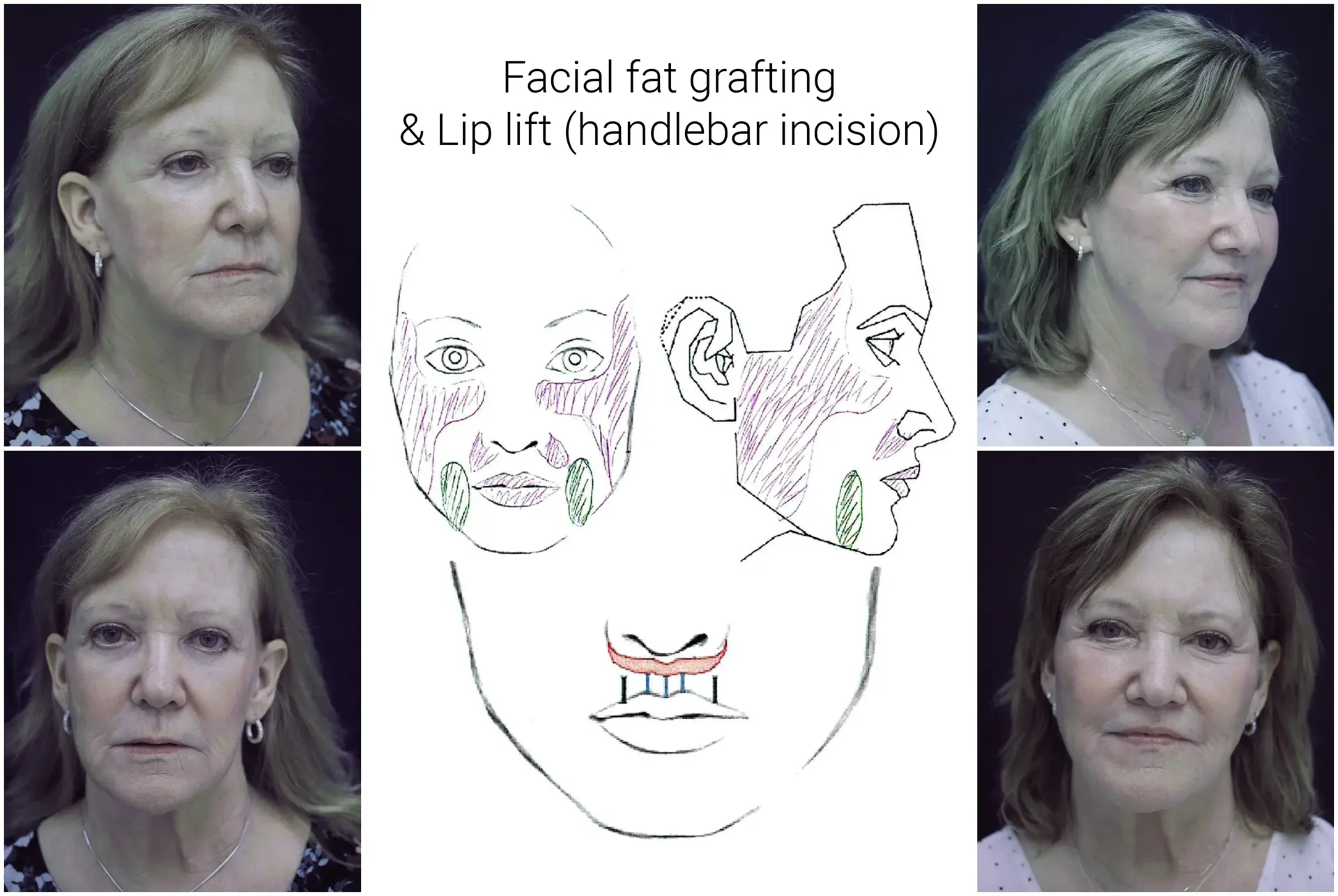
Facelifts: Not your mother’s facelift
In previous generations, patients with aging faces would consult a Plastic Surgeon for a facelift. The component parts of a full facelift were not generally described in the media; but, in general, the old style ‘full facelift ‘ would likely include all or parts of a coronal browlift, an upper/lower blepharoplasty, and a lower facelift (SMAS/deep plane). The coronal browlift had incisions in the hairline from ear to ear, leaving some patients with hair loss and involved a long recovery. In more recent decades, patients were offered a mid-facelift. Some lower face and mid face techniques also involved aggressive dissection, which carried higher complication rates. Recovery time was usually several months, with a lot of hand holding between the doctor’s office and the patient.
The biggest evolution in facelift techniques was the advent of Fat Transfer to the face, which was introduced by Dr. Sidney Colemen in NYC in the 1980’s. Fat Transfers lifted the structures of the face in the same, and even in better ways, than the old mid facelift dissection techniques. In addition, your own fat could be injected in small quantities almost anywhere on the face to rejuvenate and restore volume.
Nowadays, Fat Transfer is increasingly replacing the the mid-facelift, and the coronal browlift has been largely replaced by the endoscopic browlift. Fat transfer is now used to lift the mid-face region, and it is also used to rejuvenate other regions of the face. Lower facelift techniques have evolved so that the direction of lifting is UP, rather than diagonal. And, in addition, smaller ancillary cosmetic procedures such as the Lip Lift, Lipo to the face/neck, and injectables have assisted in sculpting personalized results. Ancillary procedures in combination with a Browlift and Fat Transfer offer wonderful results with much less down time.
With anesthesia, all of the component parts of a Facelift can now be performed under IV anesthesia. These procedures do not need to be performed under General Anesthesia where a ventilator breaths for you. With IV sedation you are breathing on your own. In my practice, I use Board Certified Anesthesiologists to monitor your IV sedation throughout the case.
Let’s take a look at the transformative potential of the facial rejuvenation procedures available today to assist you in achieving your goals for a refreshed appearance.
Facial Rejuvenation Options
Botox® and Xeomin Injections
Botox® (and Xeomin) help by blocking muscular nerve impulses and, when administered well, can be quite effective at diminishing fine lines and certain facial wrinkles. We use Xeomin more than Botox® because in my experience it performs exactly as Botox® does, but is much less expensive for the patient. The effects are temporary and usually last about 4 months.
Most healthcare providers can administer Botox® and some RN’s can be highly skilled injectors. Be sure to ask who will be doing your injections. For the safest, optimum results consider finding a plastic surgeon who performs the actual injections. In my own practice, I perform all Botox®, Xeomin and facial filler injections. If you are a new patient, the first step is to book a consult to discuss whether your specific concerns are likely to be addressed with these injections, or if other options are available. Learn more about botox injections.
Facial Fillers: Restoring volume and smoothing wrinkles
Facial fillers, like Juvederm, Restylane, Sculptra, and Radiesse, are synthetic injections which are used to add volume and smooth out fine lines and wrinkles. So unlike Botox® (which relaxes muscles to soften wrinkles), facial fillers work to “fill in” wrinkled areas.
These are temporary solutions, too, so you will need to repeat the fillers every so often. Our most commonly used fillers are Restylane and Sculptura. Restylane is often times used for lip augmentation and naso-labial folds, and will last about 6-9 months. The most common filler in my practice is Sculptra, which will restore volume to the mid face region and last a period of 2-3 years. Most patients can get a big improvement with just one vial of Sculptra. Learn more about facial fillers.
Lower Facelift: Addressing the jowls and ‘turkey neck’
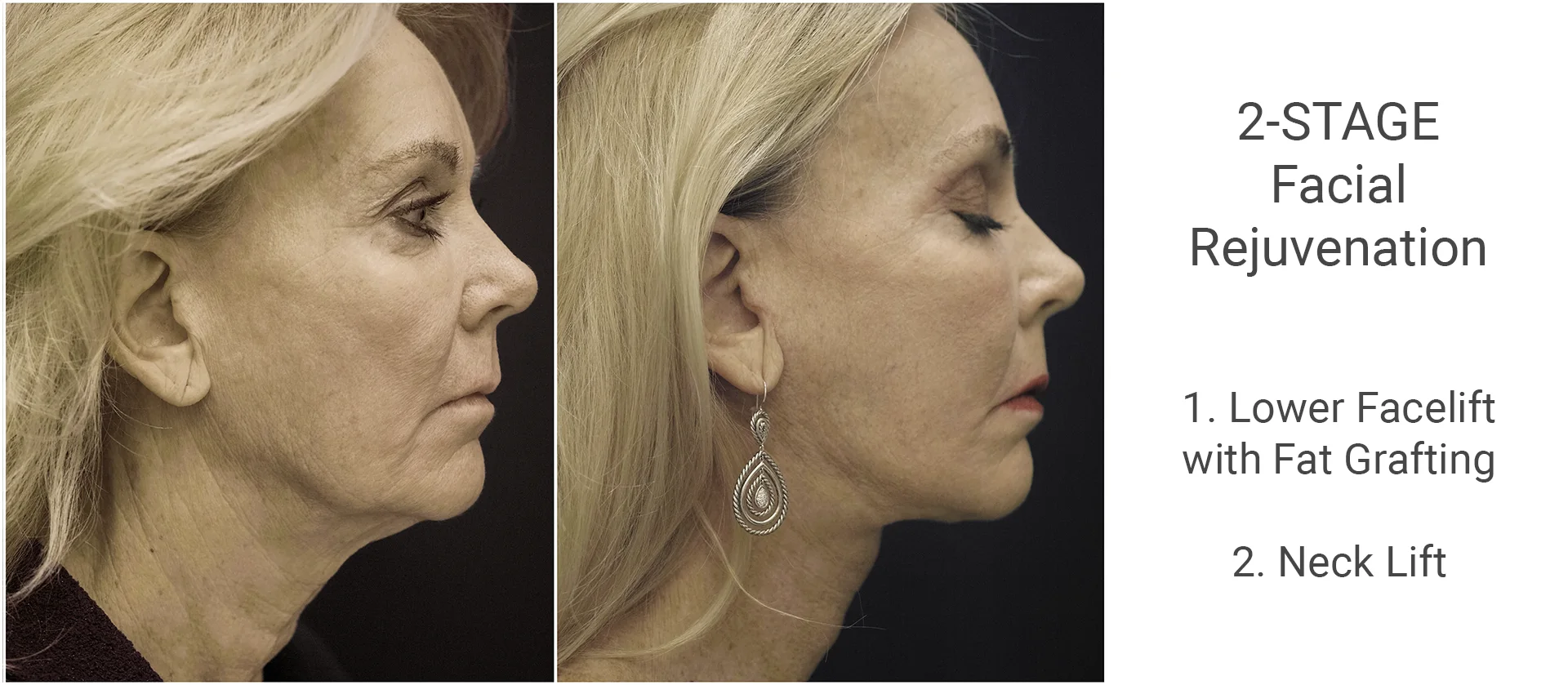
If the neck is one of your biggest concerns, you will most likely benefit from a Lower Facelift. The Lower Facelift does address droopy jowls and neck concerns. Patients who elect to have the Lower Facelift often combine it with a Fat Transfer to the upper face, or a Browlift, or both.
There are at least three types of Lower Facelifts being performed by Plastic Surgeons. They are the SMAS, deep plane, and the vertical plication methods. I have used all three techniques and years ago settled on the vertical plication method introduced by Dr. William Little more than 25 years ago. My preference for the vertical plication method in the Lower Facelift is that the lifting is UP, and not diagonal, as is primarily the case with some other techniques. These other lower facelift techniques can sometimes result in a ‘wind tunnel’ look, because the skin can look stretched out to the sides. Learn more about facelifts.
Browlifts: Elevating your look / facelift effects achieved
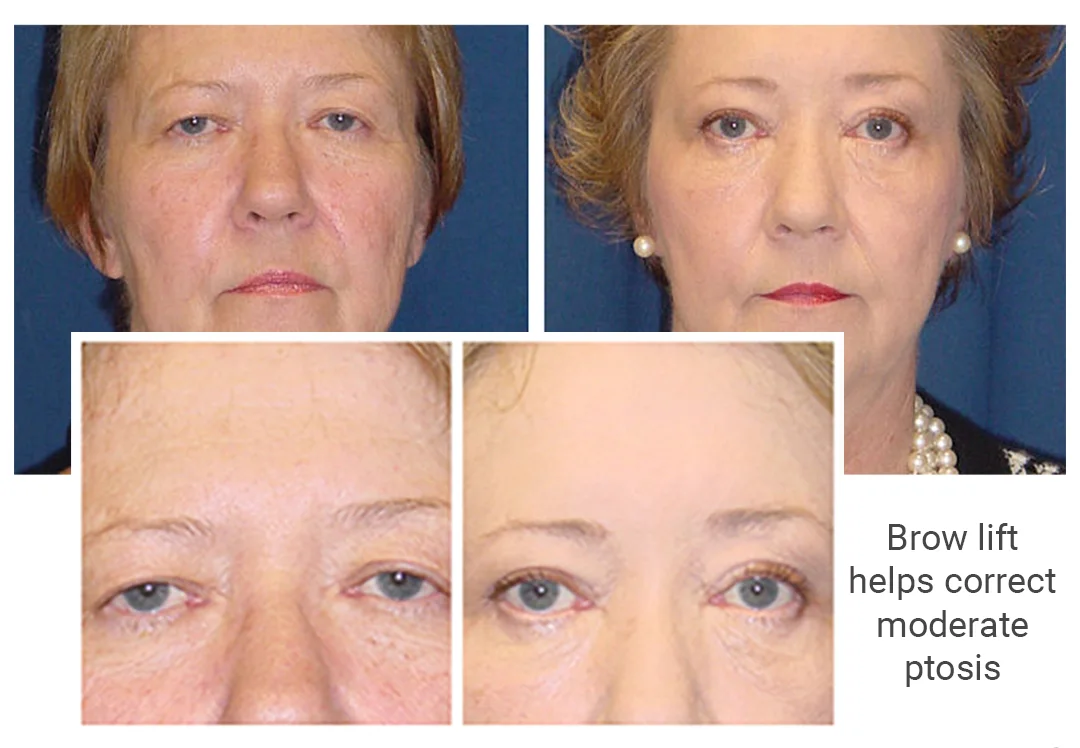
The Browlift is the most popular facial procedure that I routinely perform. The main advantage is that it will reduce the appearance of redundant skin on the eyelids and will open the eyes so that they seem more open and brighter. The other advantage of a Browlift is that it can slightly lift the upper cheek area.
This procedure will give you a refreshed, more youthful look, while still looking like YOU. A bonus of this procedure is that if you have been regularly having Xeomin or Botox®, you will no longer be in need of these injections to smooth out your forehead. These wrinkles should be greatly diminished or completely gone. In addition, there is no ‘frozen look’ after this procedure. My Browlift technique avoids this type of result where you end up looking ‘done’ instead of natural.
The Browlift does wonderful things for the upper eyelids. Patients often times think they need an Upper Blepharoplasty (upper eyelid lift). However, in the majority of cases I’ve seen, the patient is really better served with a Browlift. This is because the brow has actually fallen and causing skin to be crowding the eyes. The brow should almost always be lifted first, before there is any skin removal of the upper eyelids. Years ago, I wrote a blog article and made a video entitled, Browlift is the new Eyelift. How true that has been!
For the majority of my patients I will recommend a Browlift instead of an upper eyelid lift. It does cost more, but the result is far superior to just doing a skin removal on the eyelids. In addition you should no longer need Xeomin or Botox® in the forehead region.
If a patient has extreme drooping of the upper eyelids, I will almost always perform the Browlift first, and then if it has not fully corrected the problem, I will remove the upper eyelid skin as a second touch up procedure. Learn more about brow lifts.
Fat Transfers: Restoring volume naturally

I love doing facial fat transfers. It is a natural solution and the results are fantastic. Fat transfer is the permanent option compared to any type of filler. If you are getting fillers several times a year, it might be time to ask your Plastic Surgeon about a Fat transfer, with or without a Browlift or any other component procedures.
My most common facial fat grafting involves transferring fat to the upper face, where it is injected into the upper cheek area and around the temples. This lifts the cheeks, giving the appearance of higher cheek bones, or more definition in the bone structure in the upper face. Another common area is to inject it under the lower eyelids to fill in deep hollows.
Fat transfers work by building volume. As you age, the dermis and epidermis below the skin layer thins and causes the skin to look saggy. Fat transfers help restore volume, fill in wrinkles, and also work to create the appearance of “lifting” the mid section of the face. A well thought out fat transfer will build up some cheek bone structure in the midface region. To some extent, fat transfers can also have a tightening effect on the jowls.
To perform the Fat Transfer, a small quantity of fat is first removed from your stomach via lipo. The fat is then centrifuged in test tubes to isolate the most viable fat cells. The fat that floats to the top of the tube is discarded, and only the high density fat is used. Fat transfer are accomplished by performing scores of injections with small amounts of this high density fat.
Fat grafting has been around longer than you think. To read more about its history, which was widely popularized by Dr. Sidney Colemen in the 1980’s, read the summary I wrote about it in this article, Fat Grafting History and Applications.
In addition to the volume and structural benefits of fat grafting, it is very common to see improvements in the patient’s skin texture. The injection of your own fat will increase blood supply in the tissues of your face and do good things for the texture of your skin. I have seen this routinely in my practice during the 20+ years that I have been performing facial fat transfers!
In fact, I wrote about the stem cell facelift phenom back in 2009 and I wrote about fat grafting techniques restoring blood supply and nourishment to aging skin back in 2010. I have been very actively involved in fat grafts, stem cells, and the regenerative properties and medical potential since performing one of my first fat grafting cases in 2002. Over the years I have become more and more involved and am dedicated to the science of fat grafting. Learn more about facial fat transfers.
Lip Augmentation: Advanta Implants, Fillers, or Fat Transfer

As we age our lips tend to lose volume, becoming thinner and less defined. Lip augmentation can restore lost volume, giving the lips a fuller, more youthful appearance.
When it comes to a desire for fuller lips, you may be considering biologic tissue fillers (like Restylane and Juvederm), synthetic lip implants (like Advanta or SirgiSil), or even a Fat Transfer to the lips. There are pros and cons to each one.
Lip fillers are temporary (lasting about 6 months), whereas synthetic implants, such as Advanta, are permanent. Fat injections to the lips look beautiful and natural, however, the drawback is that you should expect to loose about 50% of the original volume injected. This is unavoidable because it is nearly impossible to limit your mouth movements for the 2 weeks required for the fat graft to ‘take.’ Even so, I do have a handful of patients who come back every few years to get another round of fat transferred to the lips because it looks so great! Learn more about lip augmentations.
Please note that there are some patients who are NOT a good candidate for lip augmentation. These patients are better suited for a Lip Lift, because additional volume in the lips will only result in unnatural-looking, overly full ‘duck lips.’ Only a Lip Lift can provide more youthful, fuller lips without running the risk of having an awful duck beak of a top lip that appears exaggerated and even sometimes comical in appearance. It is really important to discuss your specifics with a plastic surgeon because you may actually be a better candidate for a lip lift than a lip augmentation.
The goal of lip augmentation is to enhance your lips and your perioral region (the area around your lips) while maintaining a natural and aesthetically pleasing, fuller, more youthful look.
Lip Lifts: Reducing the long space above your top lip
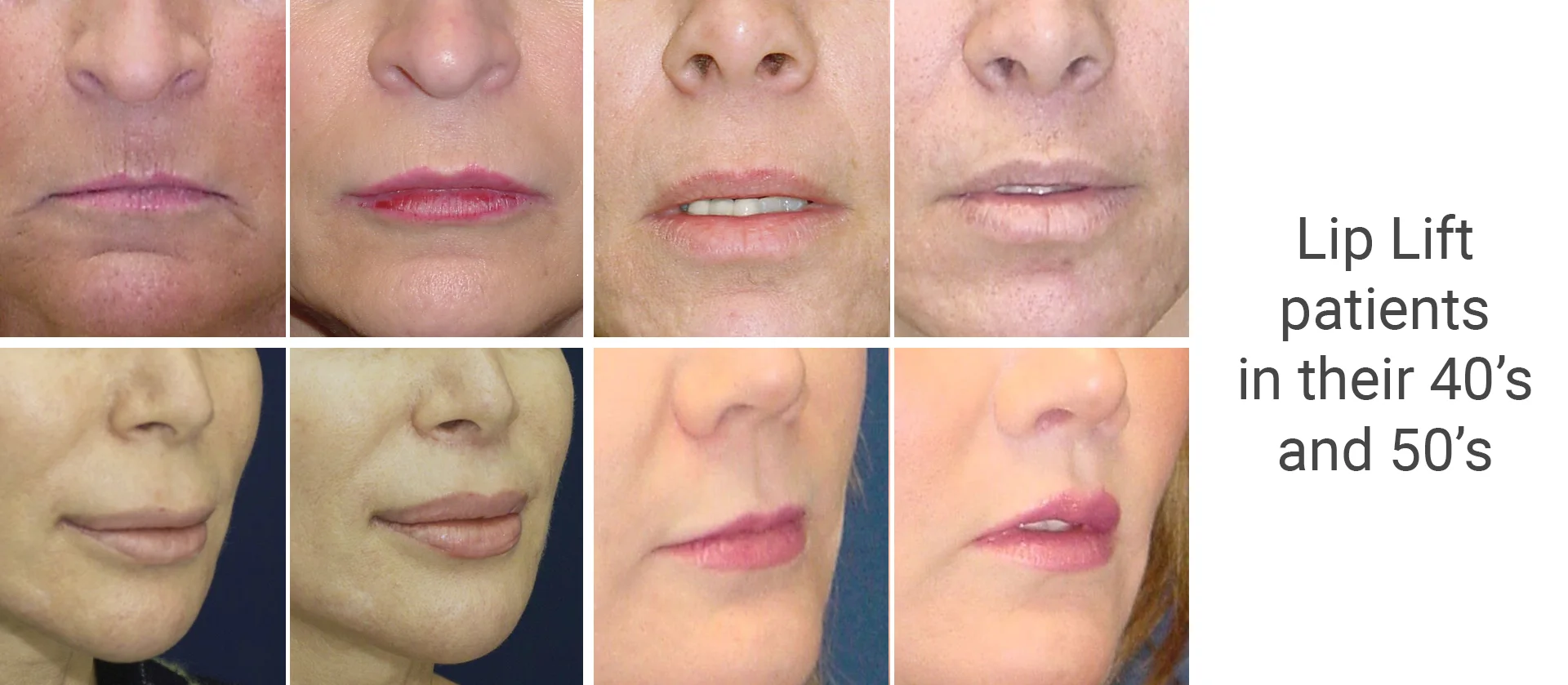
Do you have a long space between the bottom your nose and your top lip? If so, you may have noticed that your teeth no longer show, and you feel like you always look a little sad or slightly angry. If you’ve ever gotten fillers to augment your lips only to notice the increased volume causes them to protrude outward (aka duck lips), you’re likely a candidate for a lip lift instead of lip augmentation.
Beautiful lips generally have these three characteristics: a well-shaped cupid’s bow, a 1.1 cm distance between the bottom of the nose and the top lip, and a degree of fullness. You can see me talk all about lips in this video where I illustrate those characteristics and talk about lip augmentation vs a lip lift, but it is common for lip lift patients to have an excess of 3-5mm of space removed between the base of their nose and the top vermillion of the upper lip.
My Lip Lift technique involves only the removal of a small amount of skin at the base of the nose. I do not involve any nerves or muscles – no nerves are cut. I use a combination of quick disposable and permanent fixation sutures and I keep things simple to get the best upper lip lift results.
This procedure is typically performed as a local procedure, similar to when you go to the dentist. However, it can also be performed under IV anesthesia in combination with other procedures, such as a fat transfer to the face. A Lip lift offers a lot of bang for the buck, as your mouth will look more youthful and typically makes your facial expression more pleasing and relaxed. Learn more about lip lifts.
Liposuction : Liposuction to the lower Face and Jowl regions
Liposuction may not be the first procedure that comes to mind when you’re looking for facial rejuvenation, but there are certain instances where it is a valid consideration, especially in the lower face and jowl regions. Lipo, typically associated with body contouring, sometimes helps by removing excess fat deposits for an enhanced jawline definition. Lower face and/or jowl lipo is a minimally invasive procedure that is highly customizable to treat your specific needs and, with proper techniques, it can produce excellent results. Learn more about liposuction.
What Facial Procedure Combination is Right for Me?
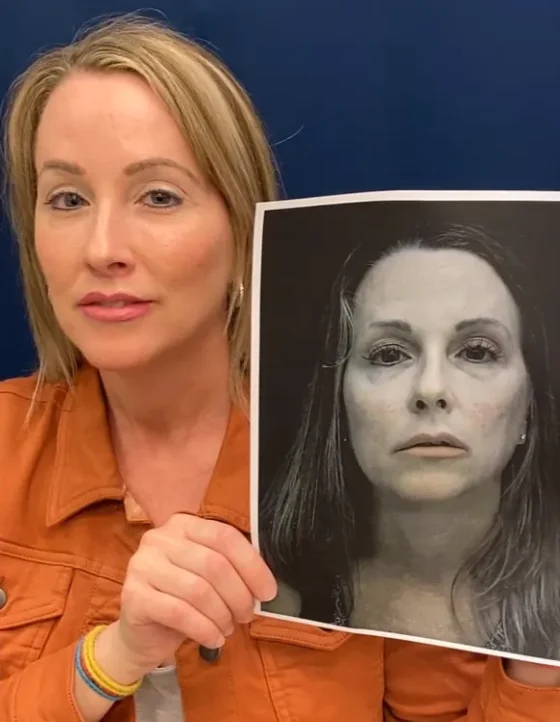
Each of the facial rejuvenation options outlined above has its unique benefits and considerations, particularly when used together. Your choice should be guided in consult with a skilled, experienced, board certified plastic surgeon who can listen to your goals and help you assess your specifics to determine procedures would help you address your concerns.
Whatever path you choose, the goal is to restore confidence and reveal a revitalized version of you.
For me here in Baltimore, more patients are opting for Browlifts with Fat transfers to the upper or full face, instead of undergoing a traditional facelift. This combination is less invasive than the old-style facelift of the past. And, in addition, the recovery for this combination is faster – and the results are fantastic!
You really can refresh your appearance with smaller component procedures that do not require weeks of recovery and do not break the bank.
Ready to discover the possibilities? The first step to a more youthful you is just a message away.
Contact us now to book your consultation! We offer both in-office and virtual consults.
Our goal is to help you look and feel your best!



